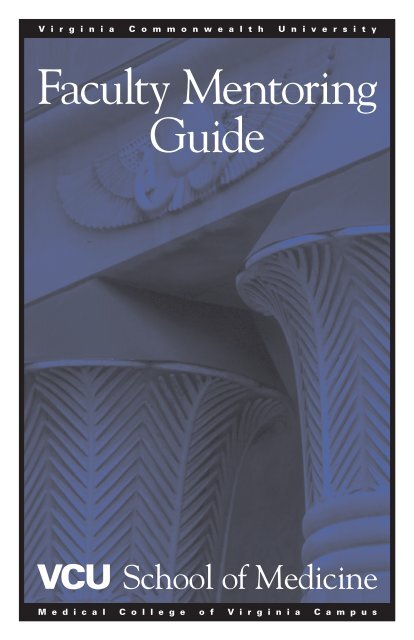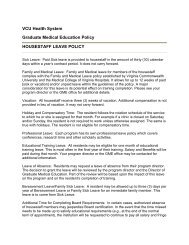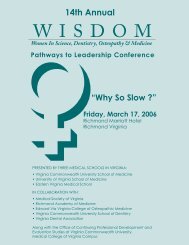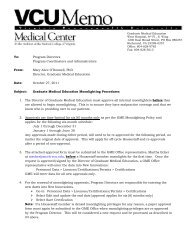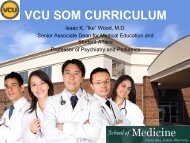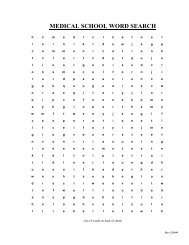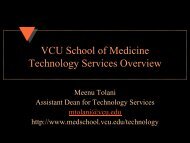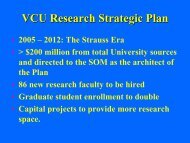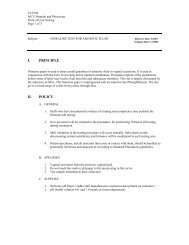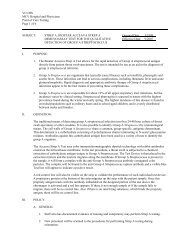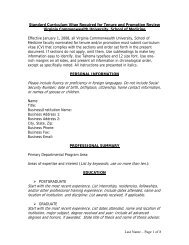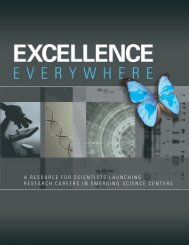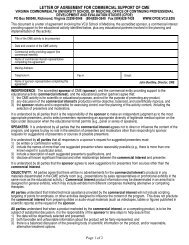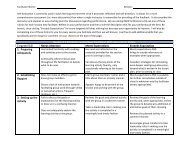Faculty Mentoring Guide - Virginia Commonwealth University ...
Faculty Mentoring Guide - Virginia Commonwealth University ...
Faculty Mentoring Guide - Virginia Commonwealth University ...
Create successful ePaper yourself
Turn your PDF publications into a flip-book with our unique Google optimized e-Paper software.
V i r g i n i a C o m m o n w e a l t h U n i v e r s i t y<br />
<strong>Faculty</strong> <strong>Mentoring</strong><br />
<strong>Guide</strong><br />
VCU School of Medicine<br />
M e d i c a l C o l l e g e o f V i r g i n i a C a m p u s
Table of Contents<br />
Foreword<br />
<strong>Mentoring</strong> Past, Present and Future. . . . . . . . . . . . . . . . . . . . . . . . . 1<br />
Suggestions for Mentors: “Why be a Mentor?” . . . . . . . . . . . . . . . . 4<br />
Characteristics of a Mentor . . . . . . . . . . . . . . . . . . . . . . . . . . . . . . . 5<br />
Finding a Mentee. . . . . . . . . . . . . . . . . . . . . . . . . . . . . . . . . . . . . . . 7<br />
Mentor’s Checklist. . . . . . . . . . . . . . . . . . . . . . . . . . . . . . . . . . . . . . 8<br />
Suggestions for Mentees: “Do I Need a Mentor?” . . . . . . . . . . . . . 10<br />
Characteristics of a Mentee . . . . . . . . . . . . . . . . . . . . . . . . . . . . . . 11<br />
Alternatives to Traditional <strong>Mentoring</strong> . . . . . . . . . . . . . . . . . . . . . 12<br />
Evaluating the Relationship. . . . . . . . . . . . . . . . . . . . . . . . . . . . . . 14<br />
Getting Started – A Primer for Departments,<br />
Divisions, Mentors, and Mentees . . . . . . . . . . . . . . . . . . . . . . . . 14<br />
National Trends in <strong>Mentoring</strong>. . . . . . . . . . . . . . . . . . . . . . . . . . . . 17<br />
Trends in Research <strong>Mentoring</strong>. . . . . . . . . . . . . . . . . . . . . . . . . . . . 18<br />
Trends in <strong>Mentoring</strong> at the VCU<br />
School of Medicine. . . . . . . . . . . . . . . . . . . . . . . . . . . . . . . . . . . 19<br />
In Conclusion . . . . . . . . . . . . . . . . . . . . . . . . . . . . . . . . . . . . . . . . 21<br />
References and Additional Resources . . . . . . . . . . . . . . . . . . . . . . 21<br />
Appendix A: Assessment Forms . . . . . . . . . . . . . . . . . . . . . . . . . . 28<br />
Appendix B: Department of Internal Medicine<br />
<strong>Mentoring</strong> Survey . . . . . . . . . . . . . . . . . . . . . . . . . . . . . . . . . . . . 33<br />
Appendix C: National Institutes of Health<br />
(NIH) <strong>Mentoring</strong> <strong>Guide</strong> Subsection . . . . . . . . . . . . . . . . . . . . . 35<br />
Appendix D: To Get a Copy of this <strong>Guide</strong> . . . . . . . . . . . . . . . . . . 36
Foreword<br />
Dear <strong>Faculty</strong> Member:<br />
The goal of <strong>Faculty</strong> Development in the School of Medicine on the Medical<br />
College of <strong>Virginia</strong> Campus of <strong>Virginia</strong> <strong>Commonwealth</strong> <strong>University</strong> is to assist faculty:<br />
• in becoming accomplished, productive, and successful in their chosen<br />
endeavors of teaching, research, patient care, or administration; and,<br />
• in sustaining their vitality, both now and in the future.<br />
<strong>Mentoring</strong> relationships have proven to be an excellent way to enhance<br />
professional growth and the School of Medicine strongly supports mentoring<br />
activities. With this in mind, the Office of <strong>Faculty</strong> and Instructional Development<br />
is offering this mentoring guide. We hope that it is useful to all faculty. When<br />
you meet with your department chair throughout the year, we encourage you to<br />
use this guide as a resource to assess your mentoring needs as they relate to your<br />
professional development.<br />
Sincerely,<br />
Heber H. Newsome, Jr., M.D.<br />
Dean, School of Medicine<br />
Carol L. Hampton, M.M.S.<br />
Associate Dean<br />
Office of <strong>Faculty</strong> and<br />
Instructional Development<br />
Published August 1997<br />
Reprinted 1999, 2001<br />
Revised March 2002
This booklet was compiled as a guide to encourage mentoring activities at<br />
the School of Medicine on the Medical College of <strong>Virginia</strong> Campus of<br />
<strong>Virginia</strong> <strong>Commonwealth</strong> <strong>University</strong>. It is not meant to be a formalized<br />
program, but rather a series of suggestions based on research concerning mentoring<br />
in health care, academia and business. <strong>Mentoring</strong> is a highly interactive process<br />
and requires strong commitment from both the mentor/guide and the mentee/protégé.<br />
Also necessary is serious commitment to mentoring from divisions, departments<br />
and the institution’s administration. This handbook is one of many steps to foster<br />
such commitment at our university.<br />
This guide is designed to help you in several ways. It will:<br />
• help you determine if you are in a position to be a mentor;<br />
• describe the rewards associated with the undertaking;<br />
• offer direction on how to seek a mentor and why you should do so whether<br />
you are a clinician, basic scientist, researcher, teacher, administrator or<br />
combination thereof;<br />
• provide a checklist of qualities to look for when seeking a mentor or a<br />
mentee;<br />
• offer alternatives to traditional mentoring;<br />
• offer suggestions for departments and divisions in devising mentoring<br />
programs;<br />
• point out potential obstacles to mentoring;<br />
• provide template forms to assess need and monitor mentoring relationships;<br />
• offer additional resources for more detailed information on mentoring.<br />
<strong>Mentoring</strong> Past, Present and Future<br />
Since the days of the Trojan War, we have many accounts of mentoring in fact<br />
and fiction, science, medicine, business, education and law. Most of us can recall<br />
some famous mentor/mentee pairs: Socrates and Plato, Haydn and Beethoven,<br />
Sigmund Freud and Carl Jung, Anne Sullivan and Helen Keller, Ruth Benedict<br />
and Margaret Mead. In each of these cases, a “senior” person who had garnered<br />
respect and an amount of prestige and power within her/his field, took a “junior”<br />
person under the wing to teach, encourage and provide an extra push to ensure<br />
that junior individual’s success. Not inconsequentially, the success of the junior<br />
person ultimately reflected on the senior person, further adding to her/his prestige.<br />
1<br />
<strong>Faculty</strong> <strong>Mentoring</strong> <strong>Guide</strong>
Different types of relationships are possible between a<br />
junior and a senior professional in an academic setting:<br />
• Those assigned by the institution (the adviser,<br />
tutor, or preceptor) and<br />
• Those chosen by the learner (the role model<br />
or the mentor).<br />
Institutionally assigned roles customarily assume the<br />
relationship to be a strictly professional one: the<br />
senior person ensures that the junior person completes<br />
institutional requirements, is progressing appropriately<br />
in his or her field of study and has the knowledge<br />
necessary to achieve career success. 31<br />
“[<strong>Mentoring</strong>] is one of the<br />
major processes through<br />
which scholars replace<br />
themselves and through<br />
which flexibility or openness<br />
to ideas and creativity or the<br />
manipulation of phenomena<br />
can be maintained.”<br />
Relationships chosen by the learner often involve a<br />
personal element in addition to professional guidance. A. Hinshaw 36<br />
A role model, for example, can provide a “vision” of a<br />
practicing professional who functions in a real world<br />
context. 31 The real world is not simply what we see<br />
from 8 to 5; it also involves the integration of personal life with professional life.<br />
The role model is usually chosen because of acknowledged status within a field and<br />
perceived competence in dealing with the challenges in his or her profession. The<br />
role model is not, however, necessarily a senior person. He or she may be a peer, and<br />
the similar age and background one of the main factors involved in the relationship.<br />
Mentors, however, are almost always senior persons within their fields. They are<br />
chosen specifically for their ability to use the power of their positions and experience<br />
to develop the careers of those less powerful and experienced. A mentor has moved<br />
beyond preoccupation with self to foster the growth of a developing professional.<br />
The precise definition of “mentor” is difficult to pin down, but in his book The<br />
Seasons of a Man’s Life, David Levinson wrote that the mentoring relationship is one<br />
of the “most complex and developmentally important” in a person’s life. Levinson did<br />
not see the relationship in formal terms, such as “teacher/student” or “boss/subordinate,”<br />
but rather in terms of its character and its functions. Several functions are<br />
considered integral in the mentoring relationship: teaching, sponsoring, guidance,<br />
socialization into a profession, provision of counsel and moral support. Of all of these,<br />
Levinson believed that the most important function of a mentor was assisting in the<br />
realization of a dream. 18<br />
<strong>Faculty</strong> <strong>Mentoring</strong> <strong>Guide</strong> 2
The relationship is, at its most fundamental, a multifaceted collaboration<br />
between a junior professional and a senior professional with the primary goal being<br />
the nurturing of the junior professional’s development. 30 In virtually every profession<br />
imaginable, a mentoring relationship is considered an excellent route toward<br />
ensuring not only a profession’s vitality, but growth of the workers within that<br />
profession. Since the days of guilds, we have recognized the synergy of the<br />
“master/novice” combination. Many industrial professions still use the apprenticeship<br />
model. In 1979, the business world turned its attention to revitalizing the<br />
concept of mentoring when an article in the Harvard Business Review reported that<br />
mentored executives earn more money at a younger age, are better educated and<br />
more likely to follow initial career goals, and enjoy greater career satisfaction. 29<br />
In health care, the concept of mentoring has traditionally been restricted to<br />
the teacher/medical student, graduate student or resident relationship. Emerging<br />
research on medical university faculty development is casting new light on mentoring<br />
as it relates to promotion, professional growth and tenure in academia. The<br />
results of the studies are sobering, especially in reference to women and minority<br />
faculty. Increases in numbers of women and minority physicians in no way<br />
guarantees them equal access to leadership positions.<br />
In 1996 3,12 and again in 2001, 43 national studies of women in U.S. academic<br />
medicine performed by the Association of American Medical Colleges (AAMC)<br />
indicate:<br />
• The proportion of full-time medical school women faculty increased from<br />
25% in 1996 to 28% in 2001.<br />
• In 1996, 21% of all associate professors were women and 10% of all full<br />
professors were women, and in 2001, the numbers are up a small percentage:<br />
24% and 12% respectively.<br />
• Also in 1996, on average, a medical school employed only 17 women full<br />
professors, including nontenured and basic sciences faculty, compared to<br />
158 men full professors per school. By 2001, on average, there are still only<br />
23 women full professors per medical school compared to 166 men at this<br />
rank. This translates to about one woman full professor per department.<br />
These statistics are particularly interesting in light of the fact that women in<br />
2001 comprise close to half of medical students (45.8%) and instructors (46%),<br />
and in 2000, 38% of residents.<br />
3<br />
<strong>Faculty</strong> <strong>Mentoring</strong> <strong>Guide</strong>
A 1990 survey of male and female medical students, house staff and faculty<br />
conducted at the <strong>University</strong> of California, San Francisco indicated:<br />
• 45% of women faculty said they had never had a mentor, compared with<br />
8% of the male faculty — males noted positive mentoring relationships<br />
three times as often as female faculty. 27<br />
A 1991 study of mentor relationships in academic medicine found:<br />
• White faculty are more likely than minority faculty to have a mentoring<br />
relationship;<br />
• Women with mentors have more publications in peer reviewed journals,<br />
spend more time in research, and report greater career satisfaction. 19<br />
Certainly such research indicates that women and minority faculty could benefit<br />
from the assistance of a senior professional who would protect the interests and<br />
guide the career path of these junior professionals so that they may achieve success<br />
in their own right. We maintain that all junior faculty could benefit from the<br />
presence of a mentor; of course, the rewards are great for the mentor, too.<br />
Suggestions for Mentors:<br />
“Why be a Mentor?”<br />
As with many professions today, medicine and<br />
academia are being asked to do more with less.<br />
Medical faculty are required to juggle clinical duties<br />
with teaching and research requirements. On an<br />
average day, physicians see patients, teach students<br />
and residents, supervise some aspect of an ongoing<br />
grant, manage and administrate. The basic scientist’s<br />
average day involves gathering data on current<br />
research grants, planning for the next grant application,<br />
advising graduate students, teaching medical,<br />
pharmacy, nursing or dental students and preparing<br />
manuscripts. Take on the added responsibility of<br />
advancing someone else’s career? Who has time?<br />
“Mentors are guides. They<br />
lead us along the journey of<br />
our lives. We trust them<br />
because they have been there<br />
before. They embody our<br />
hopes, cast light on the way<br />
ahead, interpret arcane signs,<br />
warn us of lurking dangers and<br />
point out unexpected delights<br />
along the way.” L.A. Daloz 9<br />
<strong>Faculty</strong> <strong>Mentoring</strong> <strong>Guide</strong> 4
An age-old argument against mentoring has been that it is unnecessary if only<br />
the best and brightest faculty are recruited in the first place. 11 The father of this<br />
argument, Franklin Mall, Chief of Anatomy at the Hopkins Medical School,<br />
promoted the method of teaching by not teaching, believing that individuals were<br />
responsible for their own learning. 8 (One anecdotal story about Mall concerns his<br />
wife questioning him on how to bathe their first baby. He is said to have replied,<br />
“just throw her in the water and let her work out her own technique.”)<br />
Obviously this approach is limited in its appeal and utility. The argument behind<br />
this handbook is that mentoring is a developmental stage in one’s professional life<br />
and since each developmental stage is crucial for growth, failure to serve as a mentor<br />
can lead to stagnation and internal conflict. By becoming a mentor, you have<br />
the opportunity to affect the future — you leave a part of yourself in everyone<br />
you mentor, your ideals, your ethics and your professionalism. Long after you’ve<br />
retired from the world of grants, publications, students and patients, your work will<br />
still be going on in those you’ve guided as a mentor.<br />
What are some of the characteristics of a mentor? The answers are as varied as<br />
the definition of “mentor,” but writers on the subject do point out some common<br />
10, 14, 16, 17, 21, 22, 36, 41<br />
characteristics that set a gold standard.<br />
Characteristics of a Mentor<br />
Characteristics of a mentor include:<br />
• Encourage and demonstrate confidence in your mentee.<br />
• Recognize your mentee as an individual with a private life and<br />
value her/him as a person.<br />
• Ensure a positive and supportive professional environment for your mentee.<br />
• Don’t deny your own ignorance.<br />
• Be liberal with feedback.<br />
• Encourage independent behavior, but be willing to invest ample time<br />
in your mentee.<br />
• Provide accessibility and exposure for your mentee within your own<br />
professional circle both within and outside of the immediate university circle.<br />
• Illustrate the methodology and importance of “networking” in basic science.<br />
• Allow your mentee to assist you with projects, papers and research<br />
whenever possible and be generous with credit.<br />
5<br />
<strong>Faculty</strong> <strong>Mentoring</strong> <strong>Guide</strong>
The School of Medicine, in July 1995, initiated faculty performance-based salary<br />
plans and evaluation guidelines, and these continue to the present day. Within<br />
those guidelines are the requirements for departmental and individual faculty<br />
members’ goals with respect to “teaching, research and clinical service” and how<br />
those efforts may be evaluated on an individual basis. The process of mentoring<br />
junior faculty is an excellent way to demonstrate commitment to teaching,<br />
research and service. The mission of the departments and divisions — which<br />
includes the career success of its members — can be engendered in the junior<br />
faculty by the senior faculty through a mentoring relationship. A successful<br />
mentor/mentee relationship can be a criterion for the faculty evaluation.<br />
Your relationship with your mentee can take on many different characteristics.<br />
Some may see the role requiring active prompting and occasionally even pushing<br />
to encourage success. Others may choose a more Socratic position, exposing the<br />
mentee to many options, even offering opinions, but allowing the mentee to follow<br />
his or her own path. 14 Whichever role you choose as a mentor, one factor is important<br />
above all others: while the relationship is not a marriage, you and your mentee<br />
should respect one another and share mutual regard. This seems a common-sense<br />
conclusion, but when mentoring is new to you, the old saw about separating the<br />
personal from the professional might cloud the obvious. The mentor/mentee<br />
relationship, while occurring in a professional setting, is expected to go beyond<br />
simple professional boundaries. Try not to reinforce the idea of compartmentalizing<br />
the work life and home life. Your mentee is probably struggling with that conflict<br />
already. As a mentor you must recognize that your mentee has a life outside of<br />
work and success in that life will have an impact on professional success. Help your<br />
mentee learn to integrate his or her many roles. Bolster, don’t berate, weak areas.<br />
Reinforce, don’t ignore, strong areas.<br />
A mentor’s life is challenged by another argument — one that is rooted in an<br />
appreciation of individualism and self-motivation. Our culture in general, and<br />
medical academics in particular, prides itself on the “boot strap” notion. You make<br />
your own way, going through rough terrain alone (graduate school and medical<br />
school, traineeships and residencies, post-doctoral fellowships), just the way your<br />
profession’s senior members did. Knowing that you succeeded by yourself is<br />
supposed to be its own reward. Even if that is the case, how long does the reward<br />
last? Throughout your entire career? Wouldn’t greater rewards be possible if, after<br />
having succeeded and becoming comfortable in that success, you “gave back” to<br />
someone else? Those who support the concept of mentoring believe this is the case.<br />
<strong>Faculty</strong> <strong>Mentoring</strong> <strong>Guide</strong> 6
Suppose you believe that you’re ready to be a mentor; how do you go about finding<br />
someone to be your mentee? There are several ways to do this, including being<br />
assigned to a junior faculty member by your department or division chair. This<br />
assignation method is the hallmark of a formalized mentoring program and is not<br />
precisely what we are encouraging here. While formally pairing a senior faculty<br />
member with a junior ensures that the junior has a mentor, it does not ensure that<br />
the relationship between the two will be fruitful for either. In the next section on<br />
mentees, we discuss characteristics to look for in a mentor. What about the reverse?<br />
How do you, as a senior faculty member ready to serve as a mentor, go about finding<br />
someone who could benefit from this special sort of guidance?<br />
Finding a Mentee<br />
Here are a few questions to ask yourself about finding a mentee:<br />
• Of those in my department junior to me, who is pursuing work or has<br />
strengths similar to my own?<br />
Or the converse ...<br />
• Of those in my department junior to me, who appears to be struggling in<br />
an area that is my strength? (For example, someone may be quite adept<br />
in the clinical aspects of his or her faculty position, but falling behind in<br />
publishing or in preparing grant applications.)<br />
• Among the junior faculty members, to whom do I gravitate before and after<br />
staff meetings or at social functions? (This is important in that it lets you<br />
know that you would more than likely get along personally with your<br />
mentee. Remember: this relationship encompasses more than professional<br />
development, it involves the whole person. Liking your mentee goes a long<br />
way toward a successful relationship.)<br />
While no means inclusive of all the questions you might ask yourself about your<br />
mentee, these three simple queries will get you started.<br />
You may also want to consider “plucking” your mentee out of a group — and not<br />
necessarily your own. At first glance, someone’s research may not exactly mesh with<br />
your own, but his or her style of scientific inquiry, or methodology, or teaching<br />
habits may lend themselves to a collaborative relationship with you. The<br />
mentor/mentee relationship is different. It is closer in substance to a friendship<br />
than the standard superior/subordinate relationships of the workplace. In basic<br />
science, a mentor might take on the role of sponsor, too. 21 As a mentor, you need<br />
to ensure that your mentee maintains productivity, has protected research time,<br />
understands the requirements for promotion and receives exposure via local,<br />
7<br />
<strong>Faculty</strong> <strong>Mentoring</strong> <strong>Guide</strong>
national and international organizations. 23, 30, 36 You also need to be aware, however,<br />
that obstacles may be present in the mentee’s life that interfere with such professional<br />
demands. Your job as a mentor is to help your mentee integrate the various<br />
components of his or her life, not ignore one to bolster another.<br />
Another issue to consider is your own work style. Are you self-directed or do you<br />
prefer clear rules and guidelines? As Molly Stock indicates in her book, A Practical<br />
<strong>Guide</strong> to Graduate Research, conflicts can arise when mentor and mentee are<br />
opposite types. 34 Some individuals prefer a more creative approach to their work and<br />
may be less attentive to detail, while others believe that progress occurs through<br />
careful systematic accumulation of data. A mentor who is concerned with detail and<br />
approaches research methodically may be frustrated with a mentee who has a more<br />
creative, speculative approach. This incongruence is not necessarily detrimental to<br />
either mentor or mentee, however. 34 Both types can complement each other and the<br />
research or project may be better with the inclusion of both approaches.<br />
Mentor’s Checklist (to do on a regular basis)<br />
• Set aside an hour for the first meeting with your mentee. Obtain his or her<br />
CV prior to this meeting so that you already know pertinent professional<br />
information. Use this hour to get to know other aspects of your mentee. Is he<br />
or she married? Any children? Any hobbies? Share similar information about<br />
yourself. You may want to conduct this first meeting away from the office, or go<br />
to your mentee’s “space.”<br />
• Be sure that your mentee knows how to contact you: e-mail address, telephone<br />
numbers, fax number. You also should have this information from your mentee.<br />
• Ask your mentee what he or she expects from you.<br />
• Tell your mentee what you expect.<br />
• Together, go over strengths and weaknesses. Ask what he or she sees as the most<br />
important aspect of career development.<br />
• Familiarize yourself and then your mentee with the institution’s promotion/tenure<br />
policies. The two of you can develop a “check list” that you can follow in regard<br />
to the mentee’s progress.<br />
• Either set up a regular time to meet (such as the first and third Thursday of each<br />
month), or set the next meeting at the conclusion of this meeting. Try to meet<br />
at least once a month with your mentee. Be flexible, but insistent about meeting.<br />
• With your mentee write out one-year and three-year goals for your mentee’s career.<br />
At the end of each year, re-examine those goals and determine if they’ve been met.<br />
• Obtain the mentee’s written position description from the division or department<br />
chair to ensure that the expectations of the mentor, mentee and chairperson are<br />
<strong>Faculty</strong> <strong>Mentoring</strong> <strong>Guide</strong> 8
“What debt do we owe those<br />
below us on the ladder? … the<br />
most successful mentoring<br />
occurs when the mentor guides<br />
the mentored in such a way as<br />
to become competitive for the<br />
mentor’s position. Some might<br />
perceive this as a threatening<br />
course of action. A confident<br />
and competent mentor is able<br />
to ask, ‘Do you want my job?<br />
I’ll teach you how to get it.’ It<br />
takes courage to train someone<br />
to be better; for men to see<br />
women as successors; for<br />
women to see men as OK; for<br />
women not to keep other<br />
women down; and for everyone<br />
to accept different heirs as part<br />
of the norm.” Gayle Mowbray,<br />
Chair of the Johns Hopkins<br />
<strong>University</strong> Women’s Forum 24<br />
9<br />
<strong>Faculty</strong> <strong>Mentoring</strong> <strong>Guide</strong><br />
aligned. Make sure that you and your mentee<br />
have a chair-signed position description in your files.<br />
• Be sure that your mentee is on committees and in<br />
organizations that will help him or her in career<br />
development. Invite him or her to social functions<br />
as your guest and introduce him or her to other<br />
senior members of the profession or specialty.<br />
• Ask for assistance with research or in writing<br />
a journal article and be generous with credit<br />
but teach that “authorship encompasses two<br />
fundamental principles: contribution and<br />
responsibility.” 21 Not only should he or she<br />
make significant contributions to the work<br />
reported in the paper, but be able to take<br />
responsibility for the contents of the paper.<br />
• If your mentee is interested in (or struggling in)<br />
an area that is not your strength either, actively<br />
seek others who may assist in this regard. This is<br />
called “layering” mentors and takes the pressure<br />
off one individual to be “super mentor.”<br />
• At the end of a year in the relationship, try<br />
evaluating each other (Appendix A contains<br />
samples of questions to consider). Then offer your<br />
mentee’s evaluation of your relationship to your<br />
division/department chair.<br />
• Be aware that as the relationship evolves, and your<br />
mentee progresses along his or her career path, his or<br />
her needs may change in a direction that leads away<br />
from you. This can be an awkward time for both of<br />
you, but consider it your success. You’ve helped this<br />
person develop an insight that would not otherwise<br />
have been gained without a mentor. Help him or<br />
her locate others who may take over the mentoring<br />
duties. By that time, you’ll probably have several<br />
new junior faculty seeking your guidance. You may<br />
even meet junior professionals outside of your institution<br />
who request that you serve as a mentor to them.<br />
• Never see your mentee as a threat to you. As with<br />
others we teach, we want to see them reach beyond<br />
us. Your mentee’s success is ultimately your success.
Suggestions for Mentees:<br />
“Do I Need a Mentor?”<br />
Obviously, our answer to this question is a resounding “YES!” Literature on the<br />
subject of mentoring and junior faculty development in academic medicine<br />
concurs. 1, 2, 4, 12, 22, 24, 26, 30, 36, 40 The demands of academic medicine are many and often<br />
so diverse as to seem counter to one another. You may be required to carry a patient<br />
load, serve as a teacher to medical students or residents, conduct your own research,<br />
advise graduate students, supervise others helping you with the research, ensure<br />
adequate funding for that research, publish, participate in division/department and<br />
institutional activities — and those are just the obvious duties. On top of this, you’re<br />
expected to interact with your colleagues and senior faculty in such a way that<br />
knowledge of political intricacies is imperative. Traditionally, junior faculty are<br />
thrown into this and expected to make their own way. Few question the situation<br />
since they experienced the same in undergraduate medical school and graduate<br />
science programs.<br />
In their text Mentor in a Manual: Climbing the Academic Ladder to Tenure, authors<br />
Schoenfeld and Magnan say that the transition from medical school and residency<br />
to an academic career is difficult. Newly appointed professors have a general idea<br />
about their roles, but there is no “West Point for professors.” 31 In your academic<br />
career, you’ll learn from role models and your own mistakes. Additional research<br />
on predicting career success in academic medicine indicates specific areas critical<br />
for new faculty. 23<br />
Three essential areas in which new faculty need to be socialized:<br />
• Adopting academic values;<br />
• Managing an academic career;<br />
• Establishing and maintaining a productive network of colleagues.<br />
In fact, the research suggests that these three areas are so important that they<br />
actually predict who will be a high achiever and who will not. Daunting, isn’t it?<br />
With a mentor, you would not be navigating this maze alone. You would have a<br />
guide who had walked the path before you and could help you avoid snares and blind<br />
alleys. In the previous section addressed to mentors, we mentioned the differences<br />
between pre-selected mentors chosen by divisions or departments, and self-selected<br />
mentors, chosen by the person seeking a mentor. We believe the most effective<br />
mentoring experience occurs where the seeker and the sought mutually agree to<br />
<strong>Faculty</strong> <strong>Mentoring</strong> <strong>Guide</strong> 10
the relationship. The genesis of such a relationship is up to you as the mentee.<br />
Hopefully, before you even accepted an appointment, you familiarized yourself with<br />
the department’s senior faculty, their publications, their practice and research areas<br />
and so on. If you haven’t, do so now. After coming on board as a junior faculty member,<br />
you should have the opportunity to observe the senior staff during division or<br />
department meetings and functions. Your next step is to match the professional<br />
expertise you admire with the personal qualities that would make for a collegial relationship<br />
between you and the senior faculty member. Do not be afraid to take the<br />
initiative and give the relationships and observations time to mature.<br />
As we mentioned to mentors, the importance of a personal “fit” should be<br />
considered. Differences in values can seriously undermine a mentoring relationship.<br />
A person’s professional success will seem less luminous if it is perceived to have<br />
been obtained in ways contrary to your own values. For example, if you want to<br />
protect limited family time, the senior faculty member you choose as a mentor<br />
should probably not be the person known to work a 90-hour week and sleep in<br />
the department lounge — even if that person’s career success is your goal.<br />
Congruence in values does not mean, however, simply selecting a mentor who<br />
is just like you. You can learn a great deal from differences. Senior male faculty<br />
can make excellent mentors for junior female faculty and vice versa. Senior<br />
minority faculty can set wonderful examples for junior minority faculty, but can<br />
also expand horizons for and be excellent mentors to non-minority junior faculty.<br />
Just as the previous section listed characteristics of a good mentor, this section<br />
will mention some of the characteristics of a good mentee. Remember that this<br />
relationship is a dynamic one; neither party is permitted to coast, and in the<br />
beginning, the mentee will be doing most of the work in that he or she is actively<br />
seeking the mentor.<br />
Characteristics of a Mentee<br />
Characteristics of a mentee include:<br />
10, 11, 14<br />
• Eagerness to learn and a respect and desire to learn from the person selected<br />
as the mentor;<br />
• Seriousness in the relationship;<br />
• Taking the initiative in the relationship, especially in the beginning — be<br />
politely insistent about your desire for a mentor;<br />
• Flexibility and an understanding of this senior professional’s demanding<br />
schedule (you’ll be there one day);<br />
• Promptness for all appointments;<br />
11<br />
<strong>Faculty</strong> <strong>Mentoring</strong> <strong>Guide</strong>
• Feedback, even if nothing is requested;<br />
• Interest: your mentor will ask questions about your personal and professional<br />
life in an effort to get to know you as a whole person — do the same with<br />
your mentor. He or she also has a life outside of the institution and knowing<br />
something about it can help you communicate better;<br />
• Respect: your mentor is there to help you in your career by pointing out the<br />
stepping stones, not being one; never forget the time and effort this person<br />
is taking to offer you a smoother path on the way to success.<br />
A mentor is a unique individual to you: neither friend, nor colleague, but<br />
something of a combination of these and more. Because the relationship differs<br />
from those you have with others in your department, you may feel more relaxed<br />
and less constrained by professional protocol. This is acceptable to a point, but<br />
make certain that you respect the relationship. Unless otherwise told, consider<br />
that the information your mentor shares with you is between the two of you.<br />
From the first steps of choosing your mentor to the final days of independence<br />
and your own career success, your mentoring experience will probably move through<br />
the stages of most senior/junior or master/protégé relationships: tentativeness,<br />
eagerness to please, identification with the mentor, dependence, a “second nature”<br />
comfort in communication with the mentor, and finally, independence. 13 It is<br />
during the first four stages of tentativeness, eagerness to please, mentor identification<br />
and dependence that both mentor and mentee need to be cautious. Since the two of<br />
you are not equals, the potential for exploitation on either side is present. 16 Also,<br />
both parties need to guard against over-dependence on the mentor. While this may<br />
be flattering for the mentor and comfortable for the mentee, it does nothing to<br />
promote growth for either. Overidentification with your mentor may lead you to<br />
adopt less than desirable traits, or at least traits that do not mesh with your own<br />
lifestyle (such as sitting on so many committees that you have no time to spend on<br />
personal interests).<br />
Alternatives to Traditional <strong>Mentoring</strong><br />
A mentoring relationship can be critical for your success in academic medicine.<br />
This does not mean, however, that you will only have one mentor in your career<br />
— or even just one at a time. Rarely does one senior person meet all the needs a<br />
young professional might have. This is especially true in academic medicine and<br />
basic science considering the increasing clinical demands and ever-changing<br />
research environment. Twenty-five or 30 years ago, a mentor with sound research<br />
skills may have sufficed for a junior faculty member since research has<br />
<strong>Faculty</strong> <strong>Mentoring</strong> <strong>Guide</strong> 12
traditionally been an area for which young clinical professionals received the least<br />
training. Today, this would not be the case. In this managed care, health care<br />
reform environment, a junior faculty member would need a mentor with research,<br />
clinical, teaching and business skills — a tall order for one person.<br />
Even senior faculty have strengths and weaknesses. As a mentee, you may find<br />
one individual known for research skills, another individual honored for teaching<br />
abilities and yet a third senior professional whose clinical and business acumen you<br />
admire. Ask all three to mentor you in their respective<br />
areas. This would also provide an excellent opportunity<br />
for the clinical faculty and the basic science faculty<br />
“The homogeneity of<br />
to strengthen collaborative relationships as in the case<br />
senior faculty contrasts of translational research. A basic scientist may require<br />
a patient population for final research on a project.<br />
sharply with the heterogeneity<br />
of students and<br />
Simultaneous multiple mentors can be especially<br />
helpful to the basic scientist in terms of specialized<br />
technology: the geneticist may find him or herself<br />
young faculty, many of needing complex biochemistry knowledge, or skill<br />
with a specialized instrument. Layer your mentors.<br />
whom present orientations<br />
unfamiliar to their “rolling” mentors. This often happens as a person<br />
Another option for a young professional would be<br />
progresses through his or her career, especially if he or<br />
43, 46<br />
potential mentors.”<br />
she moves on to other institutions or more specialized<br />
research or clinical interests. You may start out in<br />
your career with one mentor and “roll” over to several<br />
others as your career becomes more defined. Ideally, each of your mentors will<br />
connect you with others who may serve in the same capacity.<br />
Continuing education is an excellent way to enhance your career development.<br />
For example, course work in management, business, statistics, epidemiology or<br />
mini-sabbaticals learning new research techniques can add to your current knowledge<br />
base, direct future career goals and introduce you to people outside of your<br />
institution with whom you can network. You might even meet someone whom<br />
you’d ask to mentor you, even though he or she is not a part of your institution.<br />
13<br />
<strong>Faculty</strong> <strong>Mentoring</strong> <strong>Guide</strong>
Evaluating the Relationship<br />
Suppose you’ve found your mentor and have been involved in the relationship<br />
for several months. How do you know if you’re being adequately mentored?<br />
4, 30<br />
Evaluation:<br />
• Is your mentor academically successful? (publications, grants, committees, active<br />
research, patient referrals)<br />
• Are you interested in your mentor’s research areas and techniques?<br />
• Is your mentor easy to approach and talk with?<br />
• Does your mentor advise and encourage you with respect to your independent goals?<br />
• Do the two of you meet regularly?<br />
• Do you receive regular feedback and constructive criticism?<br />
• Does your mentor facilitate your participation in professional activities outside of<br />
the institution (regional, state, national organizations)?<br />
• Are you invited to informal gatherings of people from work?<br />
• Is your mentor your advocate within the department or division?<br />
• Does your mentor encourage you to submit grant applications, help you develop<br />
research ideas and push you to write manuscripts?<br />
• Does your mentor connect you to other senior professionals who could “fill in<br />
the gaps” in areas where he or she might be less skilled?<br />
• Has your mentor observed you in a teaching situation and provided feedback on<br />
these critical skills?<br />
While these questions may not be all-inclusive, they should give you a starting<br />
point to allow you to evaluate the mentoring relationship. As we suggested in the<br />
section addressed to mentors, a yearly reconnoitering is very important to ensure<br />
that you and your mentor are congruent in your goals for the relationship.<br />
Completing an evaluation and sitting down together to go over it will guide the<br />
direction your relationship takes in the future.<br />
Getting Started – A Primer for Departments,<br />
Divisions, Mentors and Mentees<br />
Now that we’ve gone over some of the basics involved in being a mentor and<br />
seeking one, this section will discuss the importance of department/division“buyin.”<br />
Even the most dedicated mentors and eager mentees will find themselves<br />
struggling without the explicit support of their departments and divisions. With the<br />
publication of this handbook, a recent school-wide survey assessing career development,<br />
promotion and tenure planning seminars, and other educational activities<br />
<strong>Faculty</strong> <strong>Mentoring</strong> <strong>Guide</strong> 14
addressing mentoring, the School of Medicine has demonstrated its strong support<br />
of mentoring. Now the individual departments need to do the same. There are<br />
several ways to go about the process.<br />
The Self-Directed Approach: this method involves the initiative of either the<br />
mentor or the mentee. As a mentor, you would observe junior faculty members,<br />
noting their areas of interest that match your own and offering your services as a<br />
mentor. For a mentee, the reverse occurs: you research the senior faculty, get to<br />
know them and select someone whom you admire and see as a role model and guide.<br />
The Departmental/Division Approach: this method involves the support and<br />
active participation of department and division chairs as well as all faculty within<br />
those units. A formal mentoring program would have assigned mentor/mentee<br />
pairs. 23 Often the division chair takes the responsibility to mentor or to assign mentors<br />
within the division. We believe that allowing choice will ultimately make for a<br />
better relationship. Assigned pairs might address the professional needs of the<br />
mentee, but remember, the relationship goes beyond the professional.<br />
Bottom line? The two need to like each other for the relationship to be successful.<br />
This is where free choice makes the difference.<br />
Regardless of the approach to mentoring relationships, departments and divisions<br />
may want to consider having a senior “outside” person (meaning a person who is<br />
neither mentor, nor mentee) to serve as a “third eye” of sorts. This individual should<br />
be in a senior position and able to objectively view the proposed mentor/mentee<br />
pairings. He or she may see potential difficulties within relationships that neither<br />
mentor nor mentee envisions. Also, this “third eye” may see matches between<br />
junior and senior faculty where no one else has.<br />
Support of mentoring relationships from department/division chairs is crucial.<br />
<strong>Mentoring</strong> a junior faculty member is a time-consuming process and needs to be<br />
recognized as an official part of a senior faculty member’s duties. He or she must<br />
receive the necessary support from the department, division and institution or the<br />
mentoring relationship may crumble under the weight of other departmental<br />
demands. This involves allowing the time required to function as a mentor. As a<br />
senior professional, an individual has obviously proven that he or she can research,<br />
publish and obtain funding. Department and division chairs can be most helpful at<br />
this point in the mentoring process by ensuring that senior staff are encouraged to<br />
become mentors and allowed the time to pursue the relationship.<br />
15<br />
<strong>Faculty</strong> <strong>Mentoring</strong> <strong>Guide</strong>
Role of departments and divisions:<br />
• Facilitate and encourage such relationships.<br />
• Hold mentors and mentees accountable for their roles.<br />
• Reward mentors.<br />
• Make financial investments in mentees by setting aside funds for their career<br />
development (e.g., national conferences and meetings, continuing education and<br />
career development programs).<br />
For departments and divisions interested in launching mentoring relationships, a<br />
needs assessment might be helpful. A suggested needs assessment form may be<br />
found in Appendix A. Mentors, mentees, divisions and departments may wish to<br />
use these forms as guides or develop their own ways to assess needs and progress.<br />
One excellent example of departmental efforts to<br />
foster mentoring may be found in the Department of “… the department is the<br />
Internal Medicine on the MCV Campus. This<br />
department is the largest in the medical school, seat of change, with the<br />
consisting of some 175 faculty members. In May<br />
of 2001, Department Chair, Dr. Richard Wenzel, department head the key.” 43,47<br />
developed and distributed a mentoring survey to all<br />
assistant professors “in the interest of assessing the<br />
quality and accessibility of mentoring in the department.” This ten-question survey<br />
asks first if the respondent has a mentor, and then continues with questions concerning<br />
the mentoring relationship (e.g., quantity of meeting time, grant and<br />
scholarly work review, assistance with career development). The full survey may be<br />
found in Appendix B. On the basis of this survey, a mentoring program is now in<br />
place within the Department of Internal Medicine. A cornerstone of the mentoring<br />
program requires that each division chair within the department arrange a mentor<br />
for every junior faculty member in the division. This pilot project has been shared<br />
with all School of Medicine department chairs as a possible sample for their own<br />
mentoring programs. Another way of actively encouraging mentoring within the<br />
department occurs by including a question about mentoring in the department<br />
promotion and tenure evaluations. In addition to providing a biosketch and<br />
academic preparation statement, the department’s faculty members are expected to<br />
list specific mentoring activities undertaken during the review year.<br />
<strong>Faculty</strong> <strong>Mentoring</strong> <strong>Guide</strong> 16
National Trends in <strong>Mentoring</strong><br />
Since this guide was first published in August 1997, more academic medical institutions<br />
are stepping up efforts to enhance faculty development opportunities. Many<br />
of these efforts are particularly targeted toward those professionals marginalized from<br />
the traditional tenure-track environment: predominately junior (and often female)<br />
faculty with heavy clinical loads, heavy to moderate teaching responsibilities, and<br />
little time for scholarly activities. 45,49,53<br />
As academic health care centers face serious budget constraints, faculty recruitment<br />
and retention initiatives must look beyond a basic financial compensation<br />
package. Professional development opportunities and new programs aimed at<br />
promoting innovative faculty pathways — not only tenure-track researchers/<br />
physicians — become key in building a stable base of researchers, clinicians, and<br />
educators. There are as many different strategies being developed to address these<br />
challenges as there are academic medical centers. They range from the “macro”<br />
(re-thinking the concept of tenure and what constitutes “scholarship”) to the<br />
“micro” (stopping the tenure “clock” for faculty with family responsibilities). One<br />
strategy gaining universal appeal is the development of mentoring programs. They<br />
take up little room in the budget and they have an intrinsic appeal to both junior<br />
and senior academic medicine professionals who are steeped in the tradition<br />
of passing on knowledge and experience to their students, their patients and<br />
each other.<br />
A recent report describing the initiation and maintenance of leadership programs<br />
for women in seven U.S. medical schools shows mentoring programs feature prominently<br />
in strategies to improve faculty life. 49 The schools’ mentoring programs differed<br />
from one another with some encouraging network mentoring (such as on-campus<br />
and external development workshops) and others choosing the traditional<br />
“one-on-one” approach. The needs and contexts of each institution were a factor in<br />
mentorship program design. The biggest obstacle reported was inadequate time to be<br />
a mentor or mentee after program initiation. Strategies to counter this issue include<br />
developing mentoring awards, revising promotion and tenure to require and reward<br />
mentoring, and including mentoring activities on curricula vitae.<br />
There is still a long way to go in providing academic medical faculty with<br />
adequate mentoring resources; but as more surveys and reports surface, institutions<br />
take notice. As a resource to schools developing programs, AAMC is compiling<br />
brief descriptions of medical school faculty mentoring programs. Descriptions have<br />
already been obtained from the following schools: Stanford <strong>University</strong>, <strong>University</strong><br />
17<br />
<strong>Faculty</strong> <strong>Mentoring</strong> <strong>Guide</strong>
of Arkansas, <strong>University</strong> of Wisconsin, Boston<br />
<strong>University</strong>, <strong>University</strong> of Texas-Houston, the<br />
Mayo Clinic, UCLA, <strong>University</strong> of Calgary, MCP<br />
Hahnemann and East Carolina <strong>University</strong>.<br />
Additional information about mentoring programs<br />
at these institutions can be obtained by visiting<br />
their Web sites.<br />
Trends in Research<br />
<strong>Mentoring</strong><br />
Certain particularities about the scientific<br />
research environment should be considered when<br />
developing mentoring programs for researchers.<br />
The National Science Foundation has created a<br />
new grant program to encourage institutional policy<br />
change to remove barriers to women scientists<br />
(e.g., reconfiguring the tenure track). 43, 48 The<br />
National Institutes of Health provides an online<br />
guide for training and mentoring that offers an<br />
excellent example of specific guidance for<br />
researchers: http://www1.od.nih.gov/oir/<br />
sourcebook/ethic-conduct/mentor-guide.htm.<br />
In the area of training for predoctoral and postdoctoral<br />
researchers, the deputy director for intramural<br />
research at the National Institutes of<br />
Health realized that researchers’ experiences at the<br />
Institute would be enhanced by a more explicit set<br />
of expectations. The NIH fellows themselves had<br />
been seeking improved mentoring, and the development<br />
of A <strong>Guide</strong> to Training and <strong>Mentoring</strong> in the<br />
Intramural Research Program at NIH came, in part,<br />
from their efforts. The NIH guide is divided into<br />
six sections within which specific recommendations<br />
are made. The summary may be found in<br />
Appendix C.<br />
“An academic experience in<br />
science … is a challenging and<br />
exciting intellectual pursuit. It<br />
can also be fraught with intense<br />
pressures and frustrations: how to<br />
balance a heavy courseload with<br />
family responsibilities; what<br />
research avenue to pursue; what<br />
career path to follow. Young<br />
scientists … need strong, creative<br />
mentors to provide them<br />
with wise guidance as well as<br />
with friendship. The future of<br />
science … so important to the<br />
health and prosperity of the<br />
world, depends on the skillful<br />
mentoring of each new generation<br />
by the one that precedes it.”<br />
Statement on <strong>Mentoring</strong> from<br />
Bruce Alberts, President of<br />
the National Academy of<br />
Sciences 50<br />
<strong>Faculty</strong> <strong>Mentoring</strong> <strong>Guide</strong><br />
18
The VCU School of Graduate Studies now offers its own mentoring guide<br />
geared toward basic researchers and students pursuing graduate degrees. The<br />
mentoring handbook is divided into sections concerning the general features<br />
of a mentor-trainee relationship, core values of mentoring, and a bullet list of<br />
responsibilities for both mentor and trainee. Researcher trainees have somewhat<br />
different needs from clinical medicine mentees and the Office of Graduate Studies<br />
<strong>Mentoring</strong> Handbook offers some specific suggestions addressing those differences.<br />
The handbook may be found online at http://www.vcu.edu/gradweb/pfmentor.htm.<br />
In the VCU course “Scientific Integrity,” which is open to all graduate and<br />
postgraduate trainees at VCU, Francis Macrina, Ph.D., Professor and Director,<br />
Philips Institute of Oral and Craniofacial Molecular Biology, teaches about the<br />
aspects of mentoring in research. In the 2000 edition of his textbook Scientific<br />
Integrity, Chapter 3 is devoted entirely to the topic. 21<br />
Trends in <strong>Mentoring</strong> at the VCU<br />
School of Medicine<br />
In the five years since we published The School of Medicine <strong>Faculty</strong> <strong>Mentoring</strong><br />
<strong>Guide</strong>, it has acted as a catalyst to foster mentoring initiatives on campus and spark<br />
interest at other institutions. This guide is used throughout the VCU School of<br />
Medicine, and requested at over 50 academic health centers within the United<br />
States and Canada. The Association of American Medical Colleges (AAMC)<br />
incorporated the guide as part of training in their Council of Deans Leadership<br />
Initiative. In 1998, the Society of Teachers of Family Medicine (STFM) peerreviewed<br />
and approved the mentoring guide for distribution among its membership.<br />
At least two federal grants won by VCU were influenced by the inclusion of<br />
the School of Medicine <strong>Faculty</strong> <strong>Mentoring</strong> <strong>Guide</strong> as a resource, most notably the fiveyear<br />
National Institutes of Health award for junior clinical and research faculty<br />
development in the area of “Building Interdisciplinary Research Careers in<br />
Women’s Health” (BIRCWH). In the review panel’s comments, there was particular<br />
praise for the “comprehensive faculty mentoring guide.”<br />
In February 1998, the Committee on the Status of Women and Minorities<br />
published a 15-page report on the results of a School of Medicine faculty survey<br />
assessing career development needs. 44 <strong>Mentoring</strong> placed high among the needs<br />
cited. Recommendations were made to the dean and included:<br />
• Broaden the scope of career development activities for all faculty.<br />
• Write a new faculty career development plan for all new faculty hired<br />
and include identification of a mentor.<br />
19<br />
<strong>Faculty</strong> <strong>Mentoring</strong> <strong>Guide</strong>
• Assess and update the aforementioned plan with every faculty member’s<br />
annual review.<br />
• Evaluate division and department chairs on their skills for, and outcomes<br />
of mentoring and career development of faculty.<br />
In response to these recommendations, several changes occurred concerning<br />
mentoring.<br />
1.Chair Evaluation Includes <strong>Mentoring</strong>. The dean implemented an annual<br />
evaluation of chairs by the faculty members. One evaluation criterion for all<br />
clinical department chairs is labeled: “mentoring and career development — the<br />
department chair understands and strives to meet the needs of departmental<br />
faculty and staff.”<br />
2.Distinguished Mentor Award. To better recognize mentoring in the school, in<br />
1999 a “Distinguished Mentor Award” was included among the top four Annual<br />
Teaching Awards given each year to meritorious faculty. The School of Medicine<br />
bestows this award to a faculty member who makes significant contributions<br />
to the career development of others, including mentorship to fellow faculty members,<br />
junior faculty, residents, fellows, medical and graduate students, post-doctoral<br />
students and others. A cash award is given to an individual recipient and an additional<br />
$1,000 is given to the recipient’s scholarly and educational development.<br />
Through these steps, the School of Medicine leadership encourages mentoring<br />
and fosters the development of mentoring initiatives within other offices, departments<br />
and divisions. The awards and their descriptions may be found online:<br />
http://www.medschool.vcu.edu/intranet/facdev/ann_teach_awards.htm.<br />
3. Mentorship Manual for Medical Students. Another promising mentoring trend<br />
on the School of Medicine campus has been the Fall 2001 publishing of a<br />
Mentorship Manual for Medical Students. 51 This manual, written by a rising third<br />
year medical student, was born out of a series of focus groups and an online mentorship<br />
survey offered to medical students at <strong>Virginia</strong> <strong>Commonwealth</strong> <strong>University</strong>.<br />
Its purpose is to offer guidance on finding a mentor. It was encouraged by the<br />
VCU Women in Medicine and Science faculty organization and supported<br />
by the Office of Admissions and the Office of <strong>Faculty</strong> and Instructional Development.<br />
A complete version of this manual may be found online in a PDF document:<br />
http://www.medschool.vcu.edu/intranet/download/Mentorship.pdf.<br />
The VCU School of Medicine’s commitment to mentoring makes it one of<br />
increasing numbers of academic health institutions turning toward improved<br />
faculty development through partnering the established faculty with junior faculty.<br />
Nationally, mentoring programs are gaining favor and increasing numbers of<br />
journal articles, surveys and initiatives speaking to this trend are available for<br />
anyone interested in learning more.<br />
<strong>Faculty</strong> <strong>Mentoring</strong> <strong>Guide</strong> 20
In Conclusion ...<br />
The Office of <strong>Faculty</strong> and Instructional Development at the School of Medicine<br />
encourages all departments and divisions to support and actively promote mentoring.<br />
We maintain a collection of articles and texts on the subject of mentoring and<br />
have listed many pertinent pieces in the following bibliography. Many of the<br />
School of Medicine faculty have experienced positive mentoring relationships,<br />
and are willing to assist individuals, departments and divisions in any way.<br />
References and Additional Resources<br />
1. Applegate, WB. Career development in academic medicine. American<br />
Journal of Medicine. 1990;88:263-267.<br />
2. Bickel, J. Women in medical education, a status report. The New England<br />
Journal of Medicine. 1988;319(24):1579-1584.<br />
3. Bickel J, Croft K, Galbraith A, Marshall R. Women in U.S. medicine<br />
statistics 1996. Division of Institutional Planning and Development,<br />
Association of American Medical Colleges, 1996.<br />
4. Bland CJ, Schmitz CC. Characteristics of the successful researcher and<br />
implications for faculty development. Journal of Medical Education.<br />
1986;61(22).<br />
5. Bland CJ, Schmitz CC, Stritter FT, Henry RC, Aluise JJ. Successful <strong>Faculty</strong> in<br />
Academic Medicine. New York: Springer Publishing Company, 1990.<br />
6. Boice R. <strong>Mentoring</strong> new faculty: a program for implementation. Journal of<br />
Staffing, Program and Organizational Development. 1990;8:143-160.<br />
7. Collins NN. Professional Women and Their Mentors. Englewood Cliffs, NJ:<br />
Prentice-Hall, 1983.<br />
8. Corner GW. Anatomist at Large: an Autobiography and Selected Essays. New<br />
York: Basic Books, 1958.<br />
9. Daloz LA. Effective Teaching and <strong>Mentoring</strong>: Realizing the Transformational<br />
Power of Adult Learning Experiences. San Francisco: Jossey-Bass, 1986.<br />
10. Doyle LL, Cooper G. The mentor’s mentor: the mentoring handbook, a guide<br />
to mentoring. Women’s <strong>Faculty</strong> Development Caucus, College of Medicine,<br />
<strong>University</strong> of Arkansas for Medical Sciences, 1996.<br />
21<br />
<strong>Faculty</strong> <strong>Mentoring</strong> <strong>Guide</strong>
11. Dunningham GL. The art of mentoring. The American Journal of Surgery.<br />
1996;171: 604-7.<br />
12. Enhancing the environment for women in academic medicine: resources and<br />
pathways. Association of American Medical Colleges, 1996.<br />
13. Fried LP, Francomano CA, Macdonald SM, et al. Career development for<br />
women in academic medicine. Journal of the American Medical Association.<br />
1996;276(11):898-905.<br />
14. Hoover EL. <strong>Mentoring</strong>: parenting and grandparenting. Fellowship Program in<br />
Academic Medicine for Minority Students Newsletter. 1996 Summer: 1-2.<br />
15. Hunt DM, Michael C. Mentorship: a career training and development tool.<br />
Academic Management Review. 1983;8:475-485.<br />
16. Kirk E, Reichert G. The mentoring relationship: what makes it work? Imprint.<br />
January 1992:20-21.<br />
17. Kovach TM, Moore SM. Leaders are born through the mentoring process.<br />
Journal of the American Speech-Language-Hearing Association. January<br />
1992:33-35.<br />
18. Levinson DJ, Darrow CN, Klein EG, et al. The Seasons of a Man’s Life.<br />
New York: Knopf, 1978.<br />
19. Levinson W, Kaufman K, Clark B, Tolle SW. Mentors and role models for<br />
women in academic medicine. Western Journal of Medicine. 1991;154:423-426.<br />
20. Luna G, Cullen DL. Empowering the faculty: mentoring redirected and<br />
renewed. ASHE-ERIC Higher Education Report, 1995.<br />
21. Macrina, FL. “<strong>Mentoring</strong>,” Chapter 3 in Scientific Integrity: an Introductory<br />
Text with Cases, 2nd edition. Washington, DC: American Society for<br />
Microbiology Press, 2000.<br />
22. Majure JA, et al. Pocket mentor: A manual for surgical interns and residents.<br />
Westmont, IL: Association of Women Surgeons, 1994.<br />
23. Morzinski JA, Simpson DE, Bower DJ, Diehr S. <strong>Faculty</strong> development through<br />
formal mentoring. Academic Medicine. 1994;69(4):267-269.<br />
<strong>Faculty</strong> <strong>Mentoring</strong> <strong>Guide</strong> 22
24. Mowbray G. Comments from the Chair. The Newsletter of the Johns Hopkins<br />
<strong>University</strong> Women’s Forum. 1996 Winter;6(1):1. http://jhuniverse.jhu.edu/<br />
~wforum/w96news.html<br />
25. Murray M. Beyond the Myths and Magic of <strong>Mentoring</strong>. San Francisco: Jossey-<br />
Bass, 1990.<br />
26. Ochberg RL, Barton GM, West AN. Women physicians and their mentors.<br />
Journal of the American Medical Women’s Association. 1989;44:123-126.<br />
27. Osborn ES. Women’s attitudes toward careers in academic medicine at the<br />
<strong>University</strong> of California, San Francisco. Academic Medicine. 1992;67:59.<br />
28. Phillip-Jones L. Mentors and Proteges. New York: Arbour House,1982.<br />
29. Roche GR. Much ado about mentors. Harvard Business Review. 1979;1:14-31.<br />
30. Schapira MM, Kalet A, Schwartz MD, Gerrity MS. Mentorship in general<br />
internal medicine: investment in our future. Journal of General Internal<br />
Medicine. 1992;7:248-251.<br />
31. Schoenfeld AC, Magnan R. Mentor in a Manual: Climbing the Academic<br />
Ladder to Tenure. Madison: Magna Publications, 1992.<br />
32. Slater SC. <strong>Mentoring</strong> – an enriching experience. Journal of the American<br />
Association of Speech-Language-Hearing Association. May 1993;55.<br />
33. Smith, RV. Graduate Research – A <strong>Guide</strong> for Students in the Sciences. New<br />
York: Plenum Press, 1990.<br />
34. Stock, M. A Practical <strong>Guide</strong> to Graduate Research. New York: McGraw-<br />
Hill, 1985.<br />
35. Stritter FT. Individual relationships with a learner. Paper presented at VCU,<br />
MCV Campus. Richmond, <strong>Virginia</strong>, October 10, 1996.<br />
36. Taylor LJ. A survey of mentor relationships in academe. Journal of Professional<br />
Nursing. 1992;8(1):48-55.<br />
37. The Importance of Good <strong>Mentoring</strong> is Recognized at Harvard Medical<br />
School. Mentations: News from the Office of Diversity and Community,<br />
Harvard Medical School. Fall 1995. http://www.med.harvard.edu/programs/<br />
fdd/ment/fall95/import.html (accessed April 16, 2002).<br />
23<br />
<strong>Faculty</strong> <strong>Mentoring</strong> <strong>Guide</strong>
38. U.S. Department of Health and Human Services, Council on Graduate<br />
Medical Education. Fifth Report: Women & Medicine, July 1995.<br />
39. Walters B, McNeill I. Annotated Bibliography of Women in Medicine.<br />
Toronto, Ontario: Ontario Medical Association, 1993.<br />
40. Wilkerson L. Ideas for medical education. Academic Medicine.<br />
1994;69(4):267.<br />
41. Yentsch, C, Sindermann, CJ. The Woman Scientist – meeting the challenge<br />
for a successful career. New York: Plenum Press, 1992.<br />
42. Zey MC. The Mentor Connection. Homewood, Il: Dow-Jones & Irwin, 1984.<br />
43. Bickel J. Increasing women’s leadership in academic medicine: report of the<br />
AAMC project implementation committee. 2002. Unpublished Draft.<br />
44. Buckley L, Sanders K, Shih M, Kallar S, Hampton C. Obstacles to promotion?<br />
Values of women faculty about career success and recognition. Academic<br />
Medicine, 2000;75(3):283-288.<br />
45. Cain JM, Schulkin J, Parisi V, et al. Effects of perceptions and mentorship on<br />
pursuing a career in academic medicine in obstetrics and gynecology. Academic<br />
Medicine, 2001;76(6):628-634.<br />
46. Grady-Weliky T, Kettyle C, Hundert E. New light on needs in the mentormentee<br />
relationship. In Educating for Professionalism: Creating a Culture of<br />
Humanism in Medical Education, editors D. Wear and J. Bickel. Iowa City:<br />
<strong>University</strong> of Iowa Press, 2000.<br />
47. Hecht IW, Higgerson ML, Gmelch WH, Tucker A. The Department Chair as<br />
Academic Leader. Phoenix, Arizona: Oryz Press, 1999.<br />
48. Mervis, J. NSF program targets institutional change. Science. 2001;291:2063-64.<br />
49. Morahan PS, Voytko ML, Abbuhl S, Means L, et al. Ensuring the success of<br />
women faculty at AMCs: lessons learned from the national centers of excellence<br />
in women’s health. Academic Medicine, 2001;76(1):19-31.<br />
50. Statement on mentoring from Bruce Alberts, President of the National<br />
Academy of Sciences. July 23, 1997. 12 March 2002.<br />
http://www4.nationalacademies.org/news.nsf/isbn/0309063639?OpenDocument.<br />
<strong>Faculty</strong> <strong>Mentoring</strong> <strong>Guide</strong> 24
51. Swanson, KE. Mentorship Manual for Medical Students. School of Medicine,<br />
Medical College of <strong>Virginia</strong> Campus, <strong>Virginia</strong> <strong>Commonwealth</strong> <strong>University</strong>, Fall<br />
2001.<br />
52. Thomas, DA. The truth about mentoring minorities: race matters.<br />
Harvard Business Review. April 2001;99-107.<br />
53. Yedidia MJ, Bickel J. Why aren’t there more women leaders in academic<br />
medicine? The views of clinical department chairs. Academic Medicine,<br />
2001;76(5):453-465.<br />
On the Web:<br />
http://www.mcphu.edu/col/COL_Programs.html. The MCP Hahnemann<br />
<strong>University</strong>, School of Medicine Preceptoring and mentoring program (1999).<br />
http://www.hms.harvard.edu/dcp. The Harvard <strong>University</strong> newsletter on<br />
faculty development “Mentations” often carries articles concerning mentoring and<br />
associated issues (2002, March).<br />
http://www-med.stanford.edu/school/facultymentoring/index.html. <strong>Faculty</strong> mentoring<br />
program at Stanford <strong>University</strong>, School of Medicine (2000).<br />
http://www.uth.tmc.edu/ut_general/admin_fin/planning/development/mentor/<br />
mentndx.html. <strong>University</strong> of Texas-Houston, Health Science Center. Report of the<br />
task force on mentoring (1997).<br />
http://www.ksu.edu/provost/mentfel.htm. Kansas State <strong>University</strong> <strong>Mentoring</strong><br />
program (2001).<br />
http://nextwave.sciencemag.org/features/academic_career_issues.dtl#3. Science<br />
Next Wave: An Electronic Network of the Next Generation of Scientists (1998,<br />
January 9). [Special issue on mentoring].<br />
http://www.apa.org/monitor/mar99/mentor.html. Beans, B.E. <strong>Mentoring</strong> program<br />
helps young faculty feel at home. American Psychological Association Monitor<br />
[Online], (1999, March).<br />
http://www.nap.edu/readingroom/books/mentor/. “Advisor, Teacher, Role Model,<br />
Friend: On Being a Mentor to Students in Science and Engineering,” National<br />
Academy of Sciences, National Academy of Engineering, Institute of Medicine.<br />
National Academy Press, Washington, D.C. (1997).<br />
25<br />
<strong>Faculty</strong> <strong>Mentoring</strong> <strong>Guide</strong>
http://www.mentornet.net. The e-mentoring network for women in engineering<br />
and science (2002).<br />
In Print:<br />
Altman N, Banks D, Chen P, Hardwick J, Leger C, Owen A, Stukel T. Meeting<br />
the needs of new statistical researchers. Statistical Science. 1991;6(2):163-174.<br />
Bickel, J. Women in Medicine: Getting In, Growing and Advancing. Thousand<br />
Oaks, CA: Sage Publishing, April 2000. http://www.sagepub.com<br />
Buckley LM, Sanders K, Shih M, Hampton CL. Attitudes of clinical faculty about<br />
career progress, career success and recognition, and commitment to academic medicine:<br />
Results of a survey. Archives of Internal Medicine. 2000; September;160:<br />
2625-29.<br />
Fox EC, III, Waldron JA, Bohnert P, Hishinuma ES, Nordquist CR (1998).<br />
<strong>Mentoring</strong> new faculty in a department of psychiatry. Academic Psychiatry, 1998.<br />
22(2):98-106.<br />
Gibbons A, Morell V. Key issue: <strong>Mentoring</strong>. Science. 1992; 255(5050):1368-1369.<br />
Grant L, Ward K. Promise and limits of mentoring in academic science: a look at<br />
research on impact and effectiveness. AWIS Magazine, 2000;29:6-10.<br />
Hazzard WR. <strong>Mentoring</strong> across the professional lifespan in academic. Journal of the<br />
American Geriatrics Society. 1999;47(12):1466-1470.<br />
Hill SK, Bahniuk MH, Dobos J. The impact of mentoring and collegial support on<br />
faculty success: An analysis of support behavior, information adequacy, and communication<br />
apprehension. Communication Education. 1989;38(1):15-33.<br />
Illes J, Glover GH, Wexler L, Leung ANC, Glazer GM. A model for faculty mentoring<br />
in academic radiology. Academic Radiology. 2000;7(9):717-724.<br />
Johnson JC, Jayadevappa R, Taylor L, Askew A, Williams B, Johnson B. Extending<br />
the pipeline for minority physicians: A comprehensive program for minority faculty<br />
development. Academic Medicine. 1998;73(3):237-244.<br />
<strong>Faculty</strong> <strong>Mentoring</strong> <strong>Guide</strong> 26
Johnson JC, Williams B, Jayadevappa R. <strong>Mentoring</strong> program for minority faculty at<br />
the <strong>University</strong> of Pennsylvania School of Medicine. Academic Medicine. 1999;<br />
74(4):376-379.<br />
Maack MN, Passet JE. Unwritten rules – <strong>Mentoring</strong> women faculty. Library &<br />
Information Science Research. 1993;15(2):117-141.<br />
Manaster, BJ. Survival <strong>Guide</strong> for Women Radiologists, the American Association<br />
for Women Radiologists Pocket Mentor. St. Louis, MO: Mosby, 1997.<br />
Morzinski JA, Diehr S, Bower DJ, Simpson DE. A descriptive, cross-sectional study<br />
of formal mentoring for faculty. Family Medicine. 1996;28(6):434-438.<br />
Nolan D. Women in statistics in academe: Mentors matter. Statistical Science.<br />
1992;7(2):267-272.<br />
Palepu A, Friedman RH, Barnett RC, Carr PL, Ash AS, Szalacha L, Moskowitz<br />
MA. Junior faculty members’ mentoring relationships and their professional development<br />
in U.S. medical schools. Academic Medicine. 1998;73(3):318-323.<br />
Pell AN. Fixing the leaky pipeline: Women scientists in academia. Journal of<br />
Animal Science. 1996;74(11).<br />
Rogers JC, Holloway RL, Miller SM. Academic mentoring and family medicine’s<br />
research productivity. Family Medicine. 1990;22(3):186-190.<br />
Struthers NJ. Differences in mentoring: A function of gender or organizational<br />
rank? Journal of Social Behavior & Personality. Special Issue: Gender in the<br />
Workplace. 1995;10(6):265-272.<br />
Tange KC, Hekelman FP. <strong>Mentoring</strong> needs and family medicine faculty.<br />
Family Medicine. 1990;22(3):183-185.<br />
Williams JM. Challenges for junior faculty: <strong>Mentoring</strong> and family. The Journal of<br />
the American Medical Association. 1996;276(24):1954.<br />
27<br />
<strong>Faculty</strong> <strong>Mentoring</strong> <strong>Guide</strong>
Appendix A: Assessment Forms<br />
Suggested Assessment Form for Mentees*<br />
(Complete after first year of mentoring relationship.)<br />
Circle the response that best suits your feeling toward the question.<br />
The key is as follows:<br />
1 – Strongly agree 2 – Agree 3 – Neutral 4 – Disagree 5 – Strongly Disagree<br />
• I believe that mentoring is a good idea.<br />
1 2 3 4 5<br />
• I have benefitted from the mentoring relationship.<br />
1 2 3 4 5<br />
• My mentor is readily available.<br />
1 2 3 4 5<br />
• We meet on a regular basis.<br />
1 2 3 4 5<br />
• We are congruent on our goals for my professional development.<br />
1 2 3 4 5<br />
• My mentor and I have similar values.<br />
1 2 3 4 5<br />
• My mentor respects me as a person.<br />
1 2 3 4 5<br />
• My mentor understands that I have a life outside of the institution and helps me<br />
to integrate my responsibilities.<br />
1 2 3 4 5<br />
• My mentor is generous with credit.<br />
1 2 3 4 5<br />
• My mentor has involved me in professional activities outside of this institution.<br />
1 2 3 4 5<br />
• My mentor has involved me in committees within this institution.<br />
1 2 3 4 5<br />
<strong>Faculty</strong> <strong>Mentoring</strong> <strong>Guide</strong> 28
The best things about the mentoring relationship are:<br />
I would suggest the following improvements/modifications:<br />
29<br />
<strong>Faculty</strong> <strong>Mentoring</strong> <strong>Guide</strong>
Suggested Assessment Form for Mentors*<br />
(Complete after first year of mentoring relationship.)<br />
Circle the response that best suits your feeling toward the question.<br />
The key is as follows:<br />
1 – Strongly agree 2 – Agree 3 – Neutral 4 – Disagree 5 – Strongly Disagree<br />
• I think mentoring is a good idea.<br />
1 2 3 4 5<br />
• I believe that my mentee has benefited from the relationship.<br />
1 2 3 4 5<br />
• I have personally benefited from the relationship.<br />
1 2 3 4 5<br />
• My mentee and I have similar values.<br />
1 2 3 4 5<br />
• My mentee respects me as a person.<br />
1 2 3 4 5<br />
• The relationship requires too much of my time.<br />
1 2 3 4 5<br />
• I have the support of my department/division chair for my mentoring activities.<br />
1 2 3 4 5<br />
• I have referred my mentee to other faculty for help in a specific area.<br />
1 2 3 4 5<br />
• My mentee doesn’t really need a mentor.<br />
1 2 3 4 5<br />
The best thing about mentoring is:<br />
I would suggest the following changes/modifications:<br />
<strong>Faculty</strong> <strong>Mentoring</strong> <strong>Guide</strong> 30
Could I Benefit From a Mentor, or be a Mentor?*<br />
(Suggested needs assessment for departments/divisions)<br />
On a scale of 1 to 3, circle your level of expertise for the faculty position duties<br />
listed. The key is as follows:<br />
1 – I feel competent in this area and am willing to be a mentor.<br />
2 – I feel somewhat competent in this area, but not willing to be a mentor.<br />
3 – I need mentoring in this area.<br />
Duties:<br />
• developing a promotion/tenure package<br />
1 2 3<br />
• developing a teaching portfolio<br />
1 2 3<br />
• budget writing<br />
1 2 3<br />
• curriculum development<br />
1 2 3<br />
• curriculum evaluation<br />
1 2 3<br />
• resident teaching<br />
1 2 3<br />
• resident evaluation<br />
1 2 3<br />
• graduate student teaching<br />
1 2 3<br />
• graduate student evaluation<br />
1 2 3<br />
• peer evaluation<br />
1 2 3<br />
31<br />
<strong>Faculty</strong> <strong>Mentoring</strong> <strong>Guide</strong>
• time management<br />
1 2 3<br />
• integration of clinical & research duties<br />
1 2 3<br />
• grant writing<br />
1 2 3<br />
• grant review<br />
1 2 3<br />
• research design<br />
1 2 3<br />
• research funding<br />
1 2 3<br />
• presentations<br />
1 2 3<br />
• manuscript preparation<br />
1 2 3<br />
• communication skills<br />
1 2 3<br />
• computer skills<br />
1 2 3<br />
Tabulate number of:<br />
1s ____, 2s _____, 3s _____<br />
Name: _____________________________________________________________<br />
Rank: _______________________________________________________________<br />
How long in present rank? _____________________________________________<br />
* All Assessment Forms in this appendix are adapted from <strong>University</strong> of Arkansas<br />
for the Medical Sciences The Mentor’s Mentor: The <strong>Mentoring</strong> Handbook, a <strong>Guide</strong> to<br />
<strong>Mentoring</strong>. 10<br />
<strong>Faculty</strong> <strong>Mentoring</strong> <strong>Guide</strong> 32
Appendix B: Department of Internal<br />
Medicine <strong>Mentoring</strong> Survey<br />
School of Medicine<br />
<strong>Virginia</strong> <strong>Commonwealth</strong> <strong>University</strong><br />
Medical College of <strong>Virginia</strong> Campus<br />
TO:<br />
All Assistant Professors in<br />
Department of Internal Medicine<br />
FROM: Richard P. Wenzel, M.D., M.Sc.<br />
William Branch Porter Professor and Chair<br />
Department of Internal Medicine<br />
RE:<br />
<strong>Mentoring</strong><br />
SUBJECT: In the interest of assessing the quality and accessibility of mentoring<br />
in the department, I ask your help in completing a brief questionnaire. Thank you<br />
very much.<br />
<strong>Mentoring</strong><br />
1. Do you have an assigned mentor?<br />
____ yes ____ no<br />
2. How often do you meet with your mentor?<br />
____ < 1x/wk ____ 1-3 x/wk ____ > 4x/wk<br />
3. How often do you have lunch or dinner with your mentor?<br />
____ < 1x/mo ____1-3 x/mo ____ >4x/mo<br />
4. How often has your mentor reviewed a grant or a manuscript of yours?<br />
____ < 1x/yr ____ 1-3 x/yr ____ > 4x/yr<br />
5. How often has your mentor helped you get on a national committee or a<br />
prominent journal editorial board?<br />
____ < 1x/yr ____ 1-3x/yr ____ > 4x/yr<br />
33<br />
<strong>Faculty</strong> <strong>Mentoring</strong> <strong>Guide</strong>
6. How often has your mentor helped you get an opportunity to present a paper or<br />
review at a national meeting?<br />
____ < 1x/yr ____ 1-3 x/yr ____ > 4x/yr<br />
7. Has your mentor advised you regarding Promotion &Tenure in the last year?<br />
____ yes ____ no<br />
8. Has your mentor advised you regarding networking in the last year?<br />
____ yes ____ no<br />
9. Has your mentor advised you regarding your teaching skills in the last year?<br />
____ yes ____ no<br />
10. Rate the quality of your mentor. (0 low to 100 high)<br />
____________ (score)<br />
_____________________________________________<br />
Signature (optional)<br />
<strong>Faculty</strong> <strong>Mentoring</strong> <strong>Guide</strong> 34
Appendix C: National Institutes of Health<br />
(NIH) <strong>Mentoring</strong> <strong>Guide</strong> Subsection<br />
The NIH guide is divided into six sections within which specific recommendations<br />
are made.<br />
1. The Supervisors, Mentors, and Trainees section defines<br />
• a mentor as “a person who has achieved career success and counsels and<br />
guides another for the purpose of helping him or her achieve like success”;<br />
• a research supervisor, who should “always be a mentor … with the responsibility<br />
to discuss with and advise a trainee on aspects of his or her work and<br />
professional development”; and,<br />
• a postdoctoral trainee, who “should learn to train and guide others, for<br />
example, by working with more junior individuals … or training students.”<br />
2. The section entitled Training in Scientific Investigation addresses the importance<br />
of identifying a “first-rate” research project.<br />
3. Training in Communication emphasizes the importance of oral and written<br />
communication both within the scientific community and the institutional<br />
campus.<br />
4. Training in Personal Interactions discusses the need to learn negotiation,<br />
persuasion and diplomatic skills.<br />
5. Career Planning encourages fellows at NIH to consider career pathways almost<br />
as soon as arriving at the Institute and discusses how senior researchers can assist.<br />
6. The Training in Scientific Responsibility section commands all supervisors,<br />
mentors and training institutions to ensure that all trainees learn the “legal and<br />
ethical aspects of conducting research” and develop a “sense of responsibility for<br />
the use of public resources available to them.”<br />
The entire NIH <strong>Guide</strong> may be found on the Web at<br />
http://www1.od.nih.gov/oir/sourcebook/ethic-conduct/mentor-guide.htm.<br />
35<br />
<strong>Faculty</strong> <strong>Mentoring</strong> <strong>Guide</strong>
Appendix D: To Get a Copy of This <strong>Guide</strong><br />
We thank you for reading this handbook and hope you have found it a helpful<br />
starting point. If you have any questions or comments, or would like to order additional<br />
copies of the School of Medicine <strong>Faculty</strong> <strong>Mentoring</strong> <strong>Guide</strong>, please contact:<br />
Office of <strong>Faculty</strong> and Instructional Development<br />
School of Medicine<br />
<strong>Virginia</strong> <strong>Commonwealth</strong> <strong>University</strong>, Medical College of <strong>Virginia</strong> Campus<br />
P.O. Box 980565<br />
Richmond, VA 23298<br />
Telephone: 804-828-6591<br />
e-mail: carol.hampton@vcu.edu<br />
In the subject box, please type “<strong>Mentoring</strong> <strong>Guide</strong>”<br />
This mentoring guide also is found on the Web at<br />
http://www.medschool.vcu.edu/intranet/index.html.<br />
<strong>Faculty</strong> <strong>Mentoring</strong> <strong>Guide</strong> 36
Written by<br />
Jessica L. Waugh, M.A.<br />
Editor<br />
Carol L. Hampton, M.M.S.<br />
Associate Dean<br />
<strong>Faculty</strong> and Instructional Development<br />
Reviewers<br />
Lenore Buckley, M.D., Internal Medicine and Pediatrics<br />
Francis L. Macrina, Ph.D., VCU Philips Institute<br />
Karen Sanders, M.D., Internal Medicine and Veterans Affairs Medical Center<br />
Initial Advisory Committee<br />
K. Bakeer Al-Mateen, M.D. Pediatrics<br />
Lenore M. Buckley, M.D., Internal Medicine and Pediatrics<br />
Carol L. Hampton, M.M.S., <strong>Faculty</strong> and Instructional Development<br />
Cynthia M. Heldberg, Ph.D., Admissions<br />
Francis L. Macrina, Ph.D., Microbiology and Immunology<br />
Nirbhay N. Singh, Ph.D., Psychiatry<br />
Velma J. Williams, M.A., EEO/AAS, VCU<br />
Barry Wolf, M.D., Ph.D., Human Genetics and Pediatrics<br />
On the Web:<br />
http://www.medschool.vcu.edu/intranet.index.html<br />
c <strong>Virginia</strong> <strong>Commonwealth</strong> <strong>University</strong><br />
Richmond, VA<br />
2002<br />
<strong>Virginia</strong> <strong>Commonwealth</strong> <strong>University</strong> is an equal opportunity, affirmative action university<br />
providing access to education and employment without regard to age,<br />
race, color, national origin, gender, religion, sexual orientation,<br />
veteran’s status, political affiliation or disability.


